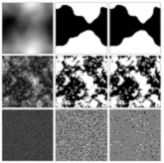Beauty, a story of complexity


The idea of a universal criteria to quantify beauty haunts artists and philosophers since Ancient Greece. Centuries after the golden number theory, Michael Benzaquen, CNRS researcher with his thesis student S. Lakhal and his collaborators A. Darmon (Art in Research) and J.-P. Bouchaud, studied this question with a new approach. Through statistical physical approach, they highlighted the existence of an optimal structural complexity in order to please the large majority. This approach also allows a quantification of this beauty criteria.
To prove this, they first generated random images of increasing “complexity” by using mathematical functions and taking inspiration from fractals. In their work published on the 15th June in the journal Physical Review research (editor’s suggestion), they had 1000 people rank these images in order of esthetical preference. The coherence of these rankings brought a clear interest for intermediate complexity images to light. Indeed, these images have enough variation to attract attention, and yet were simple enough not to be drowned in parasite “noise”.
With this in mind, they looked into the complexity found in nature and observed a similar level as what the participants preferred. Besides the bias that one would choose images resembling the most something one knows, it highlights the brain’s work to recognise structures in what we see, underlining the presence of fractals in nature herself. Bringing this structural complexity to light is one of the applications of statistical physics, which transforms it into a measurable parameter.
The authors of this work conclude that structural complexity not only can be used as an impartial and quantifiable criterion for beauty, but also that the secret of it is a balance between order and chaos.
About the chair :
The research chair « Econophysics & Complex Systems » ambitions to develop tools to understand the dynamics of economic systems, while also going beyond the very theoretical scope of the usual models. Coordinated by Michael Benzaquen, this chair uses an analytical approach derived from statistical physics models to study aggregated behaviours with interactions, heterogeneities and feedback loops. Since 2018, this research is supported by the support of Jean-Philippe Bouchaud, president of Capital fund Management, one of the France’s largest hedge funds. CFM provides both infrastructure and data to enrich the models developed by Pr Benzaquen’s team.
Holder: Michael Benzaquen, CNRS researcher at the Laboratoire d’hydrodynamique (LadHyX - a joint research unit CNRS - École polytechnique) and professor at the École Polytechnique of the Institut Polytechnique de Paris
 Support l'X
Support l'X